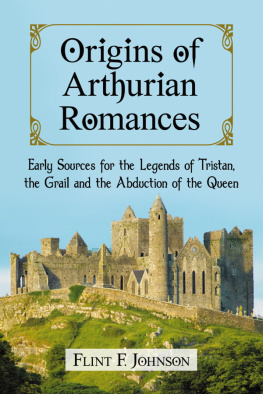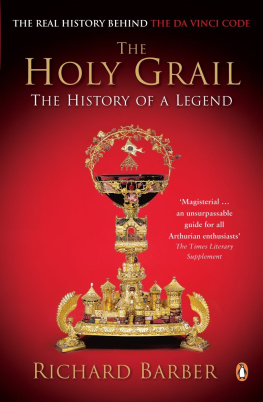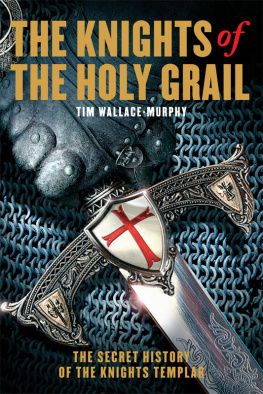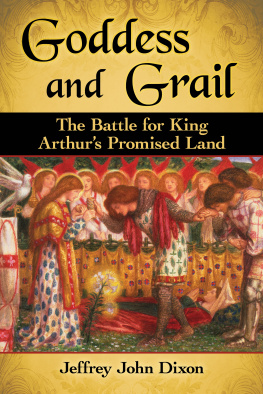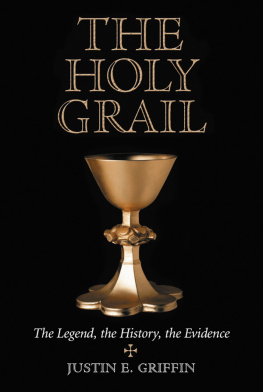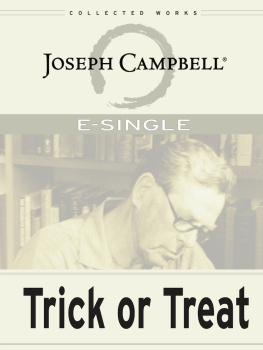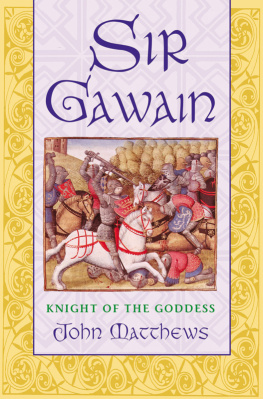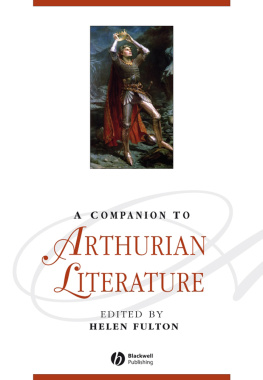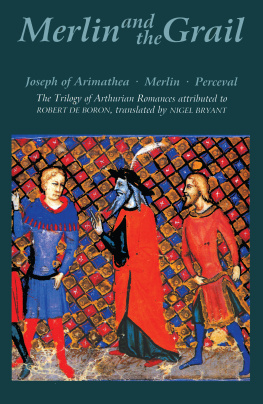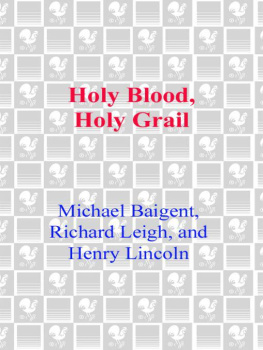
Table of Contents
Drawings provided by author.
LIBRARY OF CONGRESS CATALOGUING-IN-PUBLICATION DATA
Johnson, Flint.
Origins of Arthurian romances : early sources for the legends of Tristan, The Grail and The abduction of the queen / Flint F. Johnson.
p. cm.
Includes bibliographical references and index.
ISBN 978-0-7864-6858-4
1. Arthurian romancesSources. I. Title.
PN685 .J64 2012
809'.93351dc23 2012030664
BRITISH LIBRARY CATALOGUING DATA ARE AVAILABLE
2012 Flint F. Johnson. All rights reserved
No part of this book may be reproduced or transmitted in any form or by any means, electronic or mechanical, including photocopying or recording, or by any information storage and retrieval system, without permission in writing from the publisher.
Front cover images 2012 Shutterstock
McFarland & Company, Inc., Publishers
Box 611, Jefferson, North Carolina 28640
www.mcfarlandpub.com
Preface
This book began as an exploration of the more interesting elements of a single Arthurian story, the abduction of Arthurs queen, and slowly developed into an examination of its Celtic source materials. Certain details to be found there suggested a connection to the grail, and so the study was expanded as a result. Theories of both stories development and ideas about the nature of the grail and grail culture came naturally after that. The result was the formation of a broad methodology for examining materials from a period without strictly historical documents. The Tristan legend was the next logical step because it provided a counterpoint to all of the positive finds encountered in the first two stories; Tristan belongs securely in the realm of myth.
The result of writing in this manner is that this book is, essentially, an expanded comparative study of three Arthurian romances. Each story is treated in isolation, with all of its medieval versions discussed in terms of the development of characters and plot as well as the progression of its themes and motifs. A brief look at the bias of each author serves to demonstrate much of the variation between renderings.
With all three of the stories, there is a primary continental writer from which all later authors derived their materials. This authors biography, skills, patrons, and personal knowledge are explored more fully. Each story is then cross-referenced against the Celtic myths and legends, medieval and ancient tales, and even the culture of the period and places in which the romances were written.
The expansion beyond a traditional comparative study is due to the fact that the author is not limited by a literary approach; the methodology is cross-disciplinary in nature. Parallels for certain episodes and motifs in all the Arthurian tales have been found through the years in the history, laws, and archaeology of the Britons and Irish. These and the additional data the author was able to research add greatly to our understanding of the subject.
Making use of the historical information will prove greatly beneficial, because of where it will lead. Many of those aspects normally associated with the Arthurian romances seem to fit equally well to both the time in which they are known to have been written on the continent and to postRoman Britain in the fifth and sixth centuries. Many more details and scenes belong exclusively to that era of British history. Comparative history, extant law texts, and recovered archaeological finds of the era provide clues and insights to the three romances not found in any other approach.
Combined, the employment of additional perspectives brings the Arthurian stories, so regularly and for so long seen purely as creations of the High Middle Ages derived from Celtic folklore, into a fuller light. They show that recoverable pieces of postRoman history are lodged within them.
The following pages are an examination of three pillars of Arthurian literature using a heretofore untried methodology of applying the knowledge from several disciplines. In each of the three cases, critical studies will be utilized in determining how that story will be applied to the overall approach. With flexibility to the individual subjects, very different and more plausible theories emerge regarding the genesis and development of the Arthurian stories than have been considered previously.
Reconstructing the romance tales of the Arthurian era or any other period is not the extent of the methods applications, however. As the author hopes to demonstrate in future publications, this method is applicable to all aspects of history, which seems to defy traditional historical studies. The myths of the sir, Conchobar, Perseus, Achilles, Gilgamesh, and Maui would benefit from the same approach. Their historicity might be demonstrated by it, and the periods they lived in might be broadly mapped by applying the same tactics. In the immediate future, the author intends to show the versatility of the methodology in a study of Arthur as a historical figure and in another where the absolute and relative dates of personalities from his period are roughly laid out.
A great deal of time has passed since the manuscript was a Ph.D. thesis, and apart from the conclusions very little of what was there remains. And so, though I would again like to record my thanks to Charles Warren, Dave Schleh, Kari Fuller, Marina Moschovidou, Professor Graham Caie, Professor Rachel Bromwich, Atia Chowdhury, Dr. Richard Wilson, Professor Rex Whitehead, Professor William Gillies, and Dr. Alison Rawles; they are the people who helped me to finish the manuscript. It is to Michelle Klein that I owe the debt of helping me find the will to see my work through to publication.
Source Abbreviations
AAntiquity
ASEAnglo-Saxon England
BBulletin of the Board of Celtic Studies
CMCSCambrian (Cambridge) Medieval Celtic Studies
CRThe Chaucer Review
DVJDeutsche Vierteljahrsschrift fr Literaturwissenschaft und Geistes geschichte
ECtude Celtique
EHREnglish Historical Review
LlCLln Cymru
MAMedium vum
MLNModern Language Notes
MLRModern Language Review
MPModern Philology
NMSNottingham Medieval Studies
PMLAPublications of the Modern Language Association of America
PBAProceedings of the British Academy
PSASProceedings of the Society of Antiquaries of Scotland
RRomania
RPRomance Philology
SSpeculum
TCWAASTransactions of the Cumberland and Westmoreland Antiquarian and Archaeological Society
TDGNAHSTransactions of the Dumfriesshire and Galloway Natural History and Antiquarian Society
THSCTransactions of the Honourable Society of the Cymmrodorion
TYPTrioedd Ynys Prydein: The Welsh Triads, Rachel Bromwich (ed. and trans.)
VLDie deutsche Literature des Mittelalters
WHRWelsh History Review
ZCPZeitschrift fr Celtische Philologie
ZDPZeitschrift fr Deutsche Philologie
ZDAZeitschrift fr Deutsche Altertum
Introduction
In about 1136, a Welshman named Geoffrey of Monmouth wrote an ambitious composite of British literature and pseudohistory known as Historia Regum Britanniae. It featured a famed British figure named Arthur, who had been hitherto obscure to the continent.
Arthur was an immediate hero in medieval Western Europe, and as a result Geoffreys book would take a back seat only to the Bible in terms of copies made in the Middle Ages. His main character would even go so far as to be named one of the three Christian Worthies by antiquarians within a few centuries.
Next page
